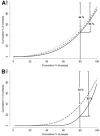Raising the level of analysis of food-borne outbreaks: food-sharing networks in rural coastal Ecuador
- PMID: 18379421
- PMCID: PMC2676440
- DOI: 10.1097/EDE.0b013e31816a9db0
Raising the level of analysis of food-borne outbreaks: food-sharing networks in rural coastal Ecuador
Abstract
Objectives: Consuming contaminated food is a well-documented individual-level risk factor for diarrheal disease. The sharing of food also influences the distribution of diarrheal disease risk through a community and region. Understanding this social process at a population level is therefore an important dimension of risk not captured by standard individual-level analyses. We examined social networks related to food-sharing in rural villages at 2 scales: within a village, examining whether connections within these networks clustered or were uniformly spread; and among villages, looking at whether food-sharing networks differed according to the village's remoteness from a population center.
Methods: We surveyed 2129 individuals aged 13 years and older in 2003-2004, within a representative (block-randomized) sample of 21 rural villages in Esmeraldas province, northern coastal Ecuador. We calculated degree (number of social contacts) for a social network defined by sharing food.
Results: Networks of households sharing food differ according to remoteness from a metropolitan center. On average, residents living in "far villages" had 2 more social contacts than those in "close villages," and 12 more years of residence in their village. Estimates of transmissibility (a measure of outbreak potential) based on network structure varied as much as 2-fold across these villages.
Conclusions: Food-sharing practices link particular households in rural villages and have implications for the spread of food-borne pathogens. The food-sharing networks in remote rural villages are heterogeneous and clustered, consistent with contemporary theories about disease transmitters. Network-based measures may offer tools for predicting patterns of disease outbreaks, as well as guidance for interventions.
Figures



Similar articles
-
Environmental change and infectious disease: how new roads affect the transmission of diarrheal pathogens in rural Ecuador.Proc Natl Acad Sci U S A. 2006 Dec 19;103(51):19460-5. doi: 10.1073/pnas.0609431104. Epub 2006 Dec 7. Proc Natl Acad Sci U S A. 2006. PMID: 17158216 Free PMC article.
-
Relating diarrheal disease to social networks and the geographic configuration of communities in rural Ecuador.Am J Epidemiol. 2007 Nov 1;166(9):1088-95. doi: 10.1093/aje/kwm184. Epub 2007 Aug 9. Am J Epidemiol. 2007. PMID: 17690221 Free PMC article.
-
Fish sharing as a risk factor for Opisthorchis viverrini infection: evidence from two villages in north-eastern Thailand.Infect Dis Poverty. 2017 Apr 4;6(1):66. doi: 10.1186/s40249-017-0281-7. Infect Dis Poverty. 2017. PMID: 28372560 Free PMC article.
-
Folic acid supplementation and malaria susceptibility and severity among people taking antifolate antimalarial drugs in endemic areas.Cochrane Database Syst Rev. 2022 Feb 1;2(2022):CD014217. doi: 10.1002/14651858.CD014217. Cochrane Database Syst Rev. 2022. PMID: 36321557 Free PMC article.
-
Epidemiology of foodborne diseases: a worldwide review.World Health Stat Q. 1997;50(1-2):30-50. World Health Stat Q. 1997. PMID: 9282385 Review.
Cited by
-
Egocentric social network characteristics and cardiovascular risk among patients with hypertension or diabetes in western Kenya: a cross-sectional analysis from the BIGPIC trial.BMJ Open. 2021 Sep 2;11(9):e049610. doi: 10.1136/bmjopen-2021-049610. BMJ Open. 2021. PMID: 34475172 Free PMC article.
-
Correlates of maternal depression, anxiety and functioning across an urban-rural gradient in northern Ecuador.Glob Public Health. 2024 Jan;19(1):2291697. doi: 10.1080/17441692.2023.2291697. Epub 2023 Dec 12. Glob Public Health. 2024. PMID: 38084739 Free PMC article.
-
Toward a systems approach to enteric pathogen transmission: from individual independence to community interdependence.Annu Rev Public Health. 2012 Apr;33:239-57. doi: 10.1146/annurev-publhealth-031811-124530. Epub 2012 Jan 3. Annu Rev Public Health. 2012. PMID: 22224881 Free PMC article. Review.
-
High prevalence of the liver fluke Amphimerus sp. in domestic cats and dogs in an area for human amphimeriasis in Ecuador.PLoS Negl Trop Dis. 2015 Feb 3;9(2):e0003526. doi: 10.1371/journal.pntd.0003526. eCollection 2015 Feb. PLoS Negl Trop Dis. 2015. PMID: 25647171 Free PMC article.
-
High prevalence of human liver infection by Amphimerus spp. flukes, Ecuador.Emerg Infect Dis. 2011 Dec;17(12):2331-4. doi: 10.3201/eid1712.110373. Emerg Infect Dis. 2011. PMID: 22172165 Free PMC article.
References
-
- Albert MJ, Neira M, Motarjemi Y. The role of food in the epidemiology of cholera. World Health Stat Q. 1997;50:111–118. - PubMed
-
- Todd EC. Epidemiology of foodborne diseases: a worldwide review. World Health Stat Q. 1997;50:30–50. - PubMed
-
- Herwaldt BL, Ackers ML. An outbreak in 1996 of cyclosporiasis associated with imported raspberries. The Cyclospora Working Group. N Engl J Med. 1997;336:1548–1556. - PubMed
-
- CDC. Oswego—An Outbreak of Gastrointestinal Illness Following a Church Supper. Case Studies in Applied Epidemiology, No. 401-303. Vol. 2007. Atlanta, GA: Centers for Disease Control and Prevention; 2003.
Publication types
MeSH terms
Grants and funding
LinkOut - more resources
Full Text Sources
Medical

